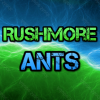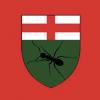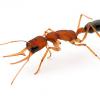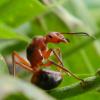- Formiculture.com
- Forums
- Gallery
- Members
- Member Map
- Chat

Imagine an ant (now with PINKOMYRMEX)
Started By
RushmoreAnts
, Sep 30 2019 9:41 AM
199 replies to this topic
#161
 Offline
-
Posted April 21 2020 - 12:35 PM
Offline
-
Posted April 21 2020 - 12:35 PM
Camponotus antarcticus
Camponotus antarcticus is a recently discovered species and the only ant native to Antarctica. They are extremely cold resistant, even more so than prenolepis imparis and build their nests in glaciers and blocks of ice. They live in the antarctic peninsula and survive off of sweets secreted by the few flowering plants that live there and prey exclusively on the antarctic midge, Antarctica's other native insect. Since the antarctic midge is a really tiny insect, camponotus antarcticus colonies are small and mostly consist of majors for tunneling through ice as well as a few minors. They also cannot survive temperatures above 15 degrees celsius (59 degrees farenheit) and will die if exposed to these conditions. Nuptial flights occur in late december and early January and consist of only a few queens and males.
Camponotus antarcticus is a recently discovered species and the only ant native to Antarctica. They are extremely cold resistant, even more so than prenolepis imparis and build their nests in glaciers and blocks of ice. They live in the antarctic peninsula and survive off of sweets secreted by the few flowering plants that live there and prey exclusively on the antarctic midge, Antarctica's other native insect. Since the antarctic midge is a really tiny insect, camponotus antarcticus colonies are small and mostly consist of majors for tunneling through ice as well as a few minors. They also cannot survive temperatures above 15 degrees celsius (59 degrees farenheit) and will die if exposed to these conditions. Nuptial flights occur in late december and early January and consist of only a few queens and males.
- RushmoreAnts likes this
My journals:
Polyergus Mexicanus: https://www.formicul...gs/#entry175528
Lasius minutus: https://www.formicul...cs/#entry174811
Lasius latipes: https://www.formicul...gs/#entry206449
General acanthomyops journal: https://www.formicul...yops-with-eggs/
Polyergus Mexicanus: https://www.formicul...gs/#entry175528
Lasius minutus: https://www.formicul...cs/#entry174811
Lasius latipes: https://www.formicul...gs/#entry206449
General acanthomyops journal: https://www.formicul...yops-with-eggs/
#162
 Offline
-
Posted April 21 2020 - 12:51 PM
Offline
-
Posted April 21 2020 - 12:51 PM
I would assume these live near the coasts..........
"God made..... all the creatures that move along the ground according to their kinds (including ants). And God saw that it was good. Genesis 1:25 NIV version
Keeping:
Formica cf. pallidefulva, cf. incerta, cf. argentea
Formica cf. aserva, cf. subintegra
Myrmica sp.
Lasius neoniger, brevicornis
#163
 Offline
-
Posted April 21 2020 - 1:22 PM
Offline
-
Posted April 21 2020 - 1:22 PM
Oecophylla solvitensis
This tropical species of Weaver ant is characterized by its unique nests and subsequent foraging (or in this case, fishing) behavior. Watertight, boat shaped nests, composed of leaves, twigs, and larval silk, float on bodies of water, mostly around coasts. These nests can be anywhere from a few inches to over a meter long, depending on colony size. Afixed to the top of the nest is series of silk sails used by the ants for navigation. Within the nest, a complex matrix of worker chains shift in specific ways to coordinate sail movement. Nests are composed of multiple "decks" and chambers, with the uppermost decks being dedicated to the navigational matrix and the bottommost to the queen and brood (brood are periodically moved to the very top to receive warmth). On top, workers scout for visual ques, wind speed, and overall weather. Behind the nest, a large net composed of silk trails behind. The net is fine enough to capture zooplankton, and strong enough to capture small fish, both of which the colony consumes for protein (for sugar, nests make stops at nectar-producing plants to fill repletes, and then set sail again). In larger colonies, many nets may be present. In the event of a landing, workers will tie the nest to a stick or rock with larval silk to secure the nest.
Upon encountering a rival seafaring colony, workers will take positions on the top deck with their gasters facing out from the ship, ready to spray formic acid. Upon contact between nests, workers will storm the other colony's deck and make off with brood, repletes, or other valuables (aphids included). Larger colonies will often target smaller ones, using larval silk to bind the nests together for easy raiding. As a countermeasure against predators such as fish, workers periodically spray the hull of the nest with toxic chemicals. Workers also refrain from casting their dead overboard to prevent attraction of predators (the dead are deposited at the same stops used for sugar resupply). If the nest should sink, the colony will immediately form rafts to protect the queen and her brood.
During nuptial flights, nests will link up (with larval silk) to exchange alates (queens and males do not fly; it's be too dangerous). If the colonies are related to eachother, the nests are detatched by the workers and both nests sail off to find another potential mating colony. New queens are given nest-building supplies by the parent colony, who's workers also assist in new nest construction. The queen alone will pilot her nest until her nanitics arrive; in the meantime, she sticks close to one of her parent nests. When nanitics arrive, the queen sails to the shore, and the new workers gather materials to develop the nest.
During times of food scarcity or other inconvenient environmental conditions, nests will sail alongside other nests in "fleets" for protection. These massive fleets can reach up to 100 nests. On rare occasions, fleets will come upon rival fleets and result in, you guessed it, ant naval warfare. Battles can sometimes last for days.
On very, very rare occasions, fleets will establish permanent coastal settlements for easy resupply of sugar and building materials. Settlements consist of a leaf nest, usually in a low bush or at the base of a tree, and makeshift "docks" along the beach so ships can dock easily. Docks are guared vigorously to prevent rival fleets or nests from exploiting the settlement's resources.
Now have sweet dreams thinking of ant naval warfare.
Edited by TheMicroPlanet, April 21 2020 - 1:32 PM.
- RushmoreAnts likes this
#164
 Offline
-
Posted April 21 2020 - 1:24 PM
Offline
-
Posted April 21 2020 - 1:24 PM
All the more reason to go boating. ![]()
- TheMicroPlanet likes this
"God made..... all the creatures that move along the ground according to their kinds (including ants). And God saw that it was good. Genesis 1:25 NIV version
Keeping:
Formica cf. pallidefulva, cf. incerta, cf. argentea
Formica cf. aserva, cf. subintegra
Myrmica sp.
Lasius neoniger, brevicornis
#165
 Offline
-
Posted April 21 2020 - 1:26 PM
Offline
-
Posted April 21 2020 - 1:26 PM
Imagine just fishing casually when, all of a sudden, a fleet of ant warships sail up beside you and wreaks havoc on your inferior vessel.
"We have you surrounded! Hand over the fish or be sprayed to smitherines!"
Edited by TheMicroPlanet, April 21 2020 - 1:33 PM.
- Manitobant and RushmoreAnts like this
#166
 Offline
-
Posted April 21 2020 - 1:27 PM
Offline
-
Posted April 21 2020 - 1:27 PM
I would imagine these would be much easier to spot than most queen ants. And you don't even have to go through the founding stage.
"God made..... all the creatures that move along the ground according to their kinds (including ants). And God saw that it was good. Genesis 1:25 NIV version
Keeping:
Formica cf. pallidefulva, cf. incerta, cf. argentea
Formica cf. aserva, cf. subintegra
Myrmica sp.
Lasius neoniger, brevicornis
#167
 Offline
-
Posted April 21 2020 - 1:32 PM
Offline
-
Posted April 21 2020 - 1:32 PM
yes exactlyI would assume these live near the coasts..........
- RushmoreAnts likes this
My journals:
Polyergus Mexicanus: https://www.formicul...gs/#entry175528
Lasius minutus: https://www.formicul...cs/#entry174811
Lasius latipes: https://www.formicul...gs/#entry206449
General acanthomyops journal: https://www.formicul...yops-with-eggs/
Polyergus Mexicanus: https://www.formicul...gs/#entry175528
Lasius minutus: https://www.formicul...cs/#entry174811
Lasius latipes: https://www.formicul...gs/#entry206449
General acanthomyops journal: https://www.formicul...yops-with-eggs/
#168
 Offline
-
Posted April 21 2020 - 1:34 PM
Offline
-
Posted April 21 2020 - 1:34 PM
I would imagine these would be much easier to spot than most queen ants. And you don't even have to go through the founding stage.
They'd be hard to keep though, i guess. It'd be the same problem with keeping army ants: space. Unless you put it in your pool ![]()
- RushmoreAnts likes this
#169
 Offline
-
Posted April 21 2020 - 1:39 PM
Offline
-
Posted April 21 2020 - 1:39 PM
yes exactlyI would assume these live near the coasts..........
Anywhere else in the continent would be much too cold for even them.
I would imagine these would be much easier to spot than most queen ants. And you don't even have to go through the founding stage.
They'd be hard to keep though, i guess. It'd be the same problem with keeping army ants: space. Unless you put it in your pool
Or a large aquarium.
"God made..... all the creatures that move along the ground according to their kinds (including ants). And God saw that it was good. Genesis 1:25 NIV version
Keeping:
Formica cf. pallidefulva, cf. incerta, cf. argentea
Formica cf. aserva, cf. subintegra
Myrmica sp.
Lasius neoniger, brevicornis
#170
 Offline
-
Posted April 21 2020 - 2:35 PM
Offline
-
Posted April 21 2020 - 2:35 PM
Super colonies would be alliances and different ships forming a fleet. You missed the chance to have nuptials take off from aircraft carriers.
- Manitobant, RushmoreAnts and TheMicroPlanet like this
#171
 Offline
-
Posted April 21 2020 - 2:36 PM
Offline
-
Posted April 21 2020 - 2:36 PM
And the queens that ride on a single leaf raft as the bravely face the elements in a race to put up a proper shelter as to found a colony.
"God made..... all the creatures that move along the ground according to their kinds (including ants). And God saw that it was good. Genesis 1:25 NIV version
Keeping:
Formica cf. pallidefulva, cf. incerta, cf. argentea
Formica cf. aserva, cf. subintegra
Myrmica sp.
Lasius neoniger, brevicornis
#172
 Offline
-
Posted April 21 2020 - 2:37 PM
Offline
-
Posted April 21 2020 - 2:37 PM
Super colonies would be alliances and different ships forming a fleet. You missed the chance to have nuptials take off from aircraft carriers.
The queens could also carry workers on their legs, which could act as dive bombers spraying enemy vessels with acid from above.
- Manitobant likes this
"God made..... all the creatures that move along the ground according to their kinds (including ants). And God saw that it was good. Genesis 1:25 NIV version
Keeping:
Formica cf. pallidefulva, cf. incerta, cf. argentea
Formica cf. aserva, cf. subintegra
Myrmica sp.
Lasius neoniger, brevicornis
#173
 Offline
-
Posted April 21 2020 - 2:46 PM
Offline
-
Posted April 21 2020 - 2:46 PM
Super colonies would be alliances and different ships forming a fleet. You missed the chance to have nuptials take off from aircraft carriers.
The queens could also carry workers on their legs, which could act as dive bombers spraying enemy vessels with acid from above.
They could enslave some Colobopsis explodens for kamikaze assaults ![]()
- Manitobant and RushmoreAnts like this
#174
 Offline
-
Posted April 21 2020 - 2:48 PM
Offline
-
Posted April 21 2020 - 2:48 PM
They're slave raiders now? ![]()
- Manitobant and TheMicroPlanet like this
"God made..... all the creatures that move along the ground according to their kinds (including ants). And God saw that it was good. Genesis 1:25 NIV version
Keeping:
Formica cf. pallidefulva, cf. incerta, cf. argentea
Formica cf. aserva, cf. subintegra
Myrmica sp.
Lasius neoniger, brevicornis
#175
 Offline
-
Posted April 21 2020 - 2:49 PM
Offline
-
Posted April 21 2020 - 2:49 PM
Not slave raiders. Pirates.
Pirates of the Formicobbean coming soon to theaters!
Edited by TheMicroPlanet, April 21 2020 - 2:50 PM.
- Manitobant and RushmoreAnts like this
#176
 Offline
-
Posted April 21 2020 - 2:58 PM
Offline
-
Posted April 21 2020 - 2:58 PM
Argh..........
"God made..... all the creatures that move along the ground according to their kinds (including ants). And God saw that it was good. Genesis 1:25 NIV version
Keeping:
Formica cf. pallidefulva, cf. incerta, cf. argentea
Formica cf. aserva, cf. subintegra
Myrmica sp.
Lasius neoniger, brevicornis
#177
 Offline
-
Posted April 21 2020 - 4:27 PM
Offline
-
Posted April 21 2020 - 4:27 PM
![]() too far man
too far man
- RushmoreAnts likes this
#178
 Offline
-
Posted April 21 2020 - 4:32 PM
Offline
-
Posted April 21 2020 - 4:32 PM
No. This is too far:
too far man
They are polymorphic, with majors exceeding 20 mm, and are cannibals. When they board other nests they eat the workers they kill, and drag the queens over to their nests and rip them to pieces. And then maybe adding a trap jaw would push it over the edge............
Edited by AntsDakota, April 21 2020 - 4:33 PM.
"God made..... all the creatures that move along the ground according to their kinds (including ants). And God saw that it was good. Genesis 1:25 NIV version
Keeping:
Formica cf. pallidefulva, cf. incerta, cf. argentea
Formica cf. aserva, cf. subintegra
Myrmica sp.
Lasius neoniger, brevicornis
#179
 Offline
-
Posted April 21 2020 - 4:59 PM
Offline
-
Posted April 21 2020 - 4:59 PM
![]()
#180
 Offline
-
Posted April 21 2020 - 5:38 PM
Offline
-
Posted April 21 2020 - 5:38 PM
"Too far" isn't an option. O. solvitensis makes submarines now.
Edited by TheMicroPlanet, April 21 2020 - 5:38 PM.
1 user(s) are reading this topic
0 members, 1 guests, 0 anonymous users

















